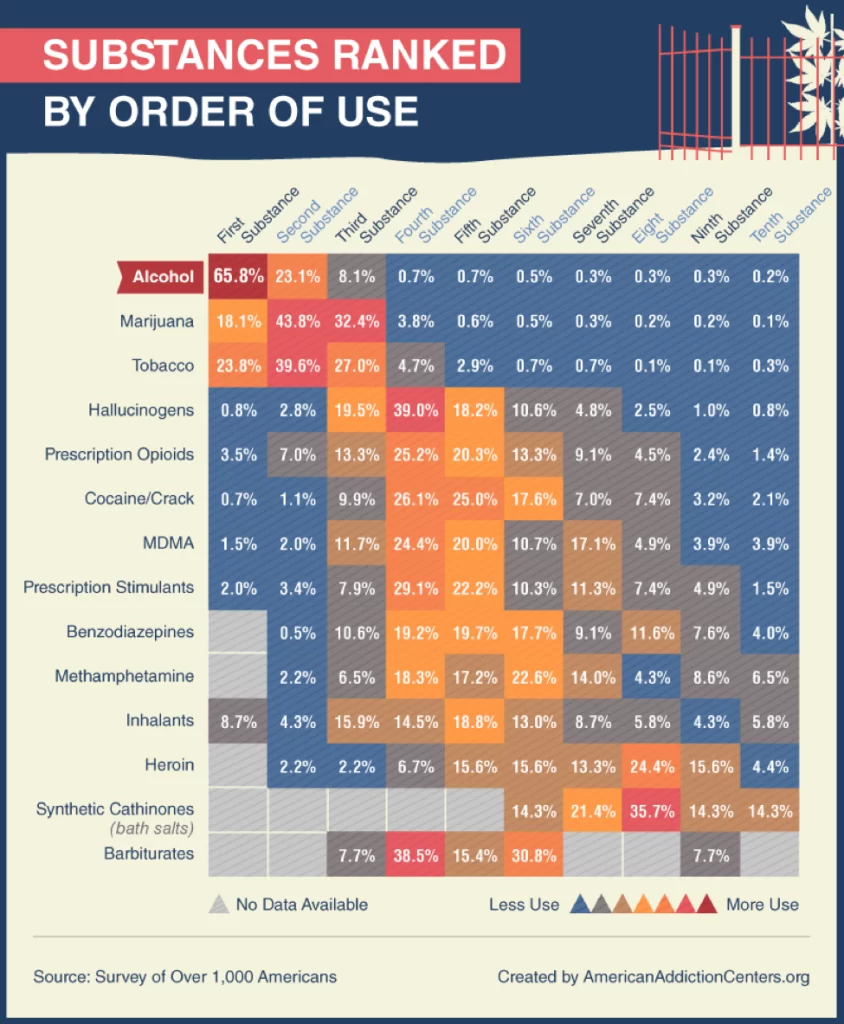The debate surrounding marijuana as a gateway drug has raged on for years. For many, it’s viewed as the first step towards more dangerous substances like cocaine, methamphetamine, or prescription opioids. But is this perception entirely accurate? A recent survey of over 1,000 Americans sheds light on the intricate journey into substance use and challenges the oversimplified gateway drug narrative.

The study delves into the sequence of substance use initiation. Surprisingly, alcohol emerges as the most common starting point, with nearly 66 percent of respondents indicating it was their first substance. This statistic underscores a concerning trend, especially among young adults aged 12 to 20, who consume a significant portion of alcohol in the form of binge drinking.
Following alcohol, marijuana and tobacco come into play as the second and third substances of choice. Interestingly, less than 6 percent of respondents experimented with marijuana after having already used three other substances. Hallucinogens usually marked the fourth substance used, followed by cocaine/crack, often coming later in the sequence.

The study reveals generational shifts in substance initiation. Alcohol, despite its known risks, remains the first substance used by 65 to 68 percent of participants. The rise in alcohol advertising expenditure, especially during the 1990s, has significantly contributed to this trend. This era witnessed the largest group of individuals trying alcohol before any other substance.
People born in the 1970s predominantly started with tobacco (23 percent), while over 10 percent chose marijuana. In contrast, those born in the 1990s most commonly initiated substance use with marijuana (almost 22 percent). This evolving pattern might explain the growing acceptance of marijuana legalization, despite potential risks like anxiety, depression, hallucinations, and paranoia.

The study also evaluates the influence of anti-substance use programs. Surprisingly, participation in these programs led to earlier experimentation with substances, contradicting the intended purpose of such initiatives. Those who engaged in anti-substance use programs started using alcohol, tobacco, marijuana, hallucinogens, and prescription opioids at younger ages compared to their non-participating counterparts. This raises questions about the effectiveness and unintended consequences of these programs.

Participants who grew up in unstable home environments initiated substance use at a significantly younger age than those from stable households. Family dynamics play a pivotal role in shaping an individual’s attitude towards substance use. Children exposed to parental substance abuse are at a higher risk of developing substance misuse disorders. According to the survey, individuals from unstable households started using alcohol at an average age of 15.1.

High school emerges as the primary stage for the initiation of alcohol, marijuana, and tobacco use. Over 64 percent of those surveyed first tried alcohol during high school, compared to around 25 percent in college. A similar pattern exists for marijuana, with nearly 48 percent experimenting in high school and almost 29 percent in college. Tobacco use, however, sees a shift, with less than 38 percent using it in high school and over 18 percent starting in college.

Surprisingly, the majority of participants did not begin substance use in isolation but with friends. Approximately 76 percent initiated substance use with one or more friends, highlighting the role of peer pressure and social context. The most common locations for the first-time use were at a friend or family member’s residence (43 percent) or at the respondent’s own home (25 percent).

Most participants didn’t stop at trying just one substance; nearly 91 percent experimented with two or more. While the most common number of different substances tried was three, including alcohol, marijuana, and tobacco, a significant portion explored four or more substances. This diverse experimentation increases the risk of developing a dangerous polysubstance addiction, emphasizing the need for comprehensive prevention and education programs.

The journey into substance use is far from straightforward, challenging the oversimplified notion of marijuana as a gateway drug. Alcohol remains the primary initiator, with generational shifts and socio-environmental factors playing a significant role. The impact of anti-substance use programs and childhood stability on initiation ages adds complexity to the issue. Understanding these intricacies is vital in shaping effective substance abuse prevention and intervention strategies.